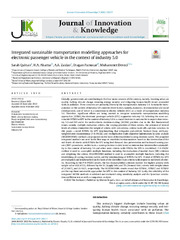Please use this identifier to cite or link to this item:
https://rfos.fon.bg.ac.rs/handle/123456789/2427Full metadata record
| DC Field | Value | Language |
|---|---|---|
| dc.creator | Qahtan, Sarah | |
| dc.creator | Alsattar, H.A. | |
| dc.creator | Zaidan, A.A. | |
| dc.creator | Pamučar, Dragan | |
| dc.creator | Deveci, Muhammet | |
| dc.date.accessioned | 2023-05-12T11:46:46Z | - |
| dc.date.available | 2023-05-12T11:46:46Z | - |
| dc.date.issued | 2022 | |
| dc.identifier.issn | 2530-7614 | |
| dc.identifier.uri | https://rfos.fon.bg.ac.rs/handle/123456789/2427 | - |
| dc.description.abstract | Globally, governments are contributing to the four main concerns of this century, namely, boosting urban air quality, halting climate change, ensuring energy security and mitigating human health issues associated with air pollution. These concerns are primarily driven by the transportation industry 5.0. Sustainable transportation in the context of Industry 5.0 considers three factors, namely, economic, environmental and social developments, one of which is a conversion to electric vehicles (EVs) as a mode of transportation industry 5.0. Therefore, significant efforts are being exerted to integrate sustainable transportation modelling approaches (ISTMA) for electronic passenger vehicle (EPV) supportive industry 5.0. Selecting the most sustainable ISTMA for EPV in the context of Industry 5.0 is a crucial decision in sustainable transportation industry 5.0 and fell under the multi-criteria decision-making (MCDM) problem due to the five fundamental issues, namely, multiple evaluation criteria, the varying priorities of these criteria, the presence of several levels of criteria diminishes the weight of criteria with sub-criteria, criteria trade-offs and data variation. In this paper, a novel ISTMAs for EPV benchmarking that integrates probabilistic hesitant fuzzy set-fuzzy-weighted zero-inconsistency (P-H-FWZIC) and multiplicative multi-objective Optimisation by ratio analysis (MULTIMOORA) methods are proposed on the basis of the established scoring decision matrix. The proposed integrated methods are used in the first stage to establish decision matrices based on the intersection of the sub-levels of criteria with ISTMAs for EPV using feed-forward data presentation and backward scoring process (BSP) procedures, on this basis, a scoring decision matrix based on intersection between the sustainability in the context of Industry 5.0 and other main criteria with ISTMAs for EPV is established. P-H-FWZIC method is used to accomplish multiple functions, including the evaluation of market share (MS) criterion and weighting the criteria. MULTIMOORA method is used to accomplish multiple functions, including the establishing of scoring decision matrix and the benchmarking of ISTMAs for EPV. A total of ISTMAs for EPV are evaluated and benchmarked on the basis of the identified main criteria with respect to sub levels of criteria. According to the P-H-FWZIC results, the Sus (Sustainability) criterion receives the highest priority with weight value of (0.4722), followed by the SS (Supply Side) and DS (Demand Side) criteria with weight values of (0.3667), and (0.1612), respectively. The MULTIMOORA results reveal that ISTMA1, ISTMA7 and ISTMA2 are the top three sustainable approaches for EPV in the context of Industry 5.0. Lastly, the reliability of the integrated MCDM methods is validated and evaluated using sensitivity analysis and the Spearman correlation coefficient test as well as comparison analysis. | en |
| dc.publisher | Elsevier B.V. | |
| dc.rights | openAccess | |
| dc.rights.uri | https://creativecommons.org/licenses/by-nc-nd/4.0/ | |
| dc.source | Journal of Innovation and Knowledge | |
| dc.subject | Sustainable transportation | en |
| dc.subject | Probabilistic hesitant fuzzy set | en |
| dc.subject | MULTIMOORA | en |
| dc.subject | Multi-criteria decision making | en |
| dc.subject | Industry 5.0 | en |
| dc.subject | Fuzzy-weighted with zero-inconsistency | en |
| dc.subject | Electric vehicle | en |
| dc.title | Integrated sustainable transportation modelling approaches for electronic passenger vehicle in the context of industry 5.0 | en |
| dc.type | article | |
| dc.rights.license | BY-NC-ND | |
| dc.citation.issue | 4 | |
| dc.citation.other | 7(4): - | |
| dc.citation.rank | aM21~ | |
| dc.citation.volume | 7 | |
| dc.identifier.doi | 10.1016/j.jik.2022.100277 | |
| dc.identifier.fulltext | http://prototype2.rcub.bg.ac.rs/bitstream/id/904/2423.pdf | |
| dc.identifier.rcub | conv_3742 | |
| dc.identifier.scopus | 2-s2.0-85139346442 | |
| dc.identifier.wos | 000868786400007 | |
| dc.type.version | publishedVersion | |
| item.cerifentitytype | Publications | - |
| item.fulltext | With Fulltext | - |
| item.grantfulltext | open | - |
| item.openairetype | article | - |
| item.openairecristype | http://purl.org/coar/resource_type/c_18cf | - |
| Appears in Collections: | Radovi istraživača / Researchers’ publications | |
This item is licensed under a Creative Commons License


